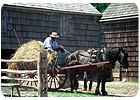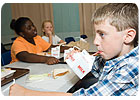
A milk-truck driver invaded a rural Amish schoolhouse and murdered five children before taking his own life. School security executives see limited strategies to protect from such rare attacks.
A MILK-TRUCK DRIVER KILLED FIVElittle girls in a one-room Amish schoolhouse at Nickel Mines, Pa. A 15-year old boy brought two guns to his Cazenovia, Wis., school and, in a tussle with his principal, killed him. A man in Bailey, Colo. grabbed six school girls, sexually assaulted them and then, when a police SWAT team stormed the facility, shot and killed one girl and then himself. In Essex, Vermont, a man looking for his ex-girlfriend at an elementary school instead killed one teacher and wounded another. In Montreal, a Columbine copycat walked into a college cafeteria, fired shots and killed one person and wounding nineteen.
The incidents happened during a handful of weeks this year, prompting U.S. President George Bush to convene a school security conference in Washington, D.C., last month. The reality is that U.S. schools are relatively safe. “The real, key issue is doing things to create the best possible school environment,” according to Joel Meyers, director of Georgia State’s Center for School Safety, School Climate and Classroom Management.

While school violence is on the minds of many, the more often group of incidents center on school bullying and gang activity.
The Perception
The perception, however, is that the schools and school children are more vulnerable from threats that are hard to anticipate and harder to protect from. About 52 million children go to school every day. There have been 224 violent school deaths since Columbine (1999).There are a diversity of policies, procedures, technologies and human resources being applied to security schools, students, teachers and administrators. A solid first step, according to Meyers, is to create and test certified safety plans. Another essential: solid communications, which is informative, all encompassing but also non-threatening and non-alarming.
Many schools are on lock-down all the time. Doors have keypads for teachers and administrators. School doors are now often-numbered so first responders can better handle situations. More schools use security video, often interfaced to law enforcement and even parents through a Web connection. In media reports, Gurnee, Ill., police crime prevention technician Tom Agos points out that “we need to raise a generation of kids who understand safety drills, just like they understand fire drills and tornado drills.”
Ironically, a $5 million program from the U.S. De- partment of Home- land Security is paying for weather warning radios for all 97,000 public schools in the U.S. At the same time, school security ex- ecutives and local law enforcement officials complain about the lack of shared communication during school violence incidents.
Visitors are another concern, says Howard Safir, the former New York City Police Commissioner and consultant. “What’s missing in some schools is a database so that school security can check a person against it.”
School violence statistics show that most incidents center on suicide and suicide-murder situations, which, according to Safir, complicate any prevention plans. There is also gang violence in urban schools. Some of the most recent incidents, however, have been situated in rural and far suburban areas.
In the past, numerous school systems brought in metal detectors. After the latest spate of violence, some have looked at the solution again. However, some school security consultants warn against depending solely on detectors because they must be manned, as compared to security video and other solutions, and that the detectors are a chock point when it comes to typical traffic patterns. It’s the same for ID badging and school uniforms. More schools issue badges but often do not update the information regularly nor check the badges at entrances and events. Uniforms play more to a community culture.
